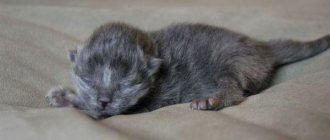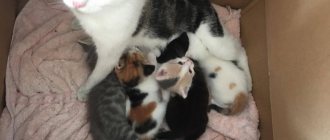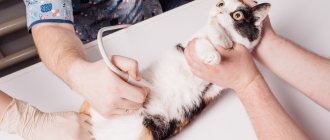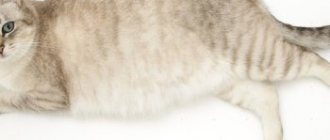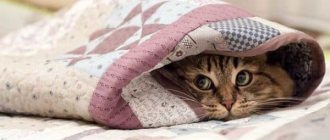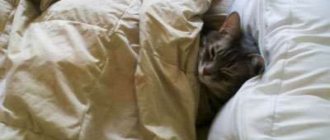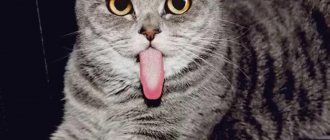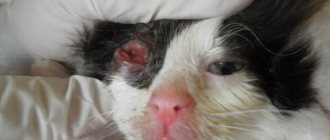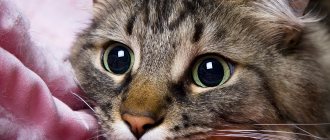Reasons that force a cat to hide kittens
| Cause | Reasons for animal behavior |
| Excessive curiosity of household members towards newborn babies | The animal worries that even the beloved owners often look into the nest, ceases to perceive the place as safe, and seeks to hide the cubs. The chosen place does not meet the safety conditions. In nature, the priority when choosing a nest is secrecy, secrecy from prying eyes, and inaccessibility to predators. Therefore, the cat chooses secluded corners for its offspring, where it can safely feed the cubs. If for some reason the place becomes restless and open, the cat tends to find another nest and drag the kittens into it |
| The cat drags the kittens to a new place, usually when they grow up and switch to solid food | At approximately 3-4 weeks of age, the offspring “moves” closer to food resources (to a bowl of food). Milk is no longer the main food of the cubs at this age, and the female tries to place a new nest closer to the food source |
| Inadequacy of the bed for raising offspring | The place with kittens can be cold, damp, hot. Drafts, excessive light, proximity to other animals are often the reason why a cat drags kittens to another place. When the nest loses its neat appearance over time due to excrement and litter contamination, the caring mother will also look for a new, cleaner home |
| The place for kittens is not suitable for their size | The cause of a cat's anxiety can be either a nest that is too large or a nest that is too small. At first, when the cubs are small, the cat may not like a spacious box. A place inappropriate for the size of the litter seems unprotected to the animal, vulnerable to enemies, and she begins to drag the kittens. This phenomenon is often observed on the 2nd - 3rd day after lambing. |
| Owners often observe how a caring mother constantly carries the same kitten and hides it. The reason why a cat takes one kitten away from others may be its poor health or excessive activity. | In the first case, the cat tries to provide the sick baby with a better place. If the baby screams the loudest, then the mother can take him away to ensure the safety of the rest of the offspring. In the wild, a predator will quickly find a nest because of a noisy kitten, and the female will take the source of noise away from the rest of the cubs |
| The reason for persistently dragging your offspring may be postpartum eclampsia | This pathological condition occurs due to a lack of calcium in the body, which is accompanied by a disorder in the animal’s nervous system. After childbirth, females become restless, aggressive, and inadequate |
| The selected location does not meet safety conditions | In nature, the priority when choosing a nest is secrecy, secrecy from prying eyes, and inaccessibility to predators. Therefore, the cat chooses secluded corners for its offspring, where it can safely feed the cubs. If for some reason the place becomes restless and open, the cat tends to find another nest and drag the kittens into it |
Why does a cat drag kittens?
Considering the fact that felines are smart creatures, dragging babies to a new place has good reason. They are guided by maternal instinct, which encourages them to preserve the viability of their offspring.
Table 3. Factors that cause a cat to bear offspring
| Incentive motive | Interpretation |
| Excessive curiosity of people towards newborns | If the owners constantly look into the nest, the female ceases to perceive it as reliable. In their natural habitat, animals hide their offspring in places remote from strangers and inaccessible to predators. Therefore, the cat always looks for a place with minimal traffic. |
| Close location to power source | 3 weeks after lambing, babies need additional feeding in addition to mother's milk. During this period, the animal tries to equip a home next to the kitchen. |
| The cat's inexperience | After the first lambing, not everyone becomes good mothers. Some females perceive the squeaking of babies as dissatisfaction with the location of the nest. In an effort to please the newborns, the cat moves the newborns to a new location. |
| Bad conditions | Dampness, drafts, cold, elevated air temperatures, and excessive light are not suitable for keeping offspring. |
| Contamination of the nest | Over time, the place where kittens are kept becomes dirty. Feces, secretions of the sebaceous glands and other cat waste have a negative impact on the condition of the litter and sanitary conditions in general. |
| Inconsistency between nest and kitten sizes | A box that is too large or small from the female's point of view is not suitable for keeping kittens. For example, for small children, a spacious basket will be unprotected and accessible to predators. Or, conversely, over time the box becomes narrow for older kittens. In any case, the female will go in search of a more comfortable place to place her offspring. |
| Excessive loudness in babies | If the kitten screams very loudly, in order to protect the rest of the offspring, the female will move it to another place. Indeed, in its natural habitat, a predator will easily find shelter at the sound of a baby’s squeak. |
| Postpartum eclampsia | A lack of calcium leads to a painful condition accompanied by disruptions in the functioning of the nervous system. Cats show excessive anxiety towards kittens and become aggressive. Females in this state are characterized by constantly dragging their babies to new nests. |
In some cases, carrying kittens by the withers is a characteristic feature of the breed. Similar behavior is observed in Bengal cats.
Female Bengal breeds often keep themselves busy carrying kittens
Negative consequences
Despite the fact that in most cases a change of place is dictated by safety and hygiene considerations, it can be life-threatening for children:
- Hit the floor. If the female is frightened during the transfer of kittens, she may drop the fragile newborn. A fall from the height of an adult cat is fatal.
- Injury to teeth. When dragging, the cat strongly squeezes the withers of the babies with its teeth. If the female is distracted, she may clench her jaw and cause harm.
- Staying unattended. When frequently transporting kittens, a cat sometimes forgets some of the offspring in the old place. Without milk and warmth, they die.
At the moment of dragging, you should not take the babies away from the cat. This will cause clenching of the jaws and injure the skin.
Kittens in the female's teeth should not be touched
Criteria for selecting a suitable location
Before building a nest for the future brood, the cat spends several days searching for the ideal corner. From the animal's point of view, it must have the following characteristics:
- secluded;
- difficult to reach;
- with dim lighting;
- hidden from prying eyes;
- cosy;
- clean;
- no pungent odors;
- warm.
Often females choose the master's closets with clean linen.
The choice of location is determined by the character of the cat. Compliant animals kitten in a place prepared in advance for them. Those who are self-sufficient and independent may refuse on principle the proposed nest. How to make a house for a cat? Read in the special article.
Cats love to create a home for babies in nightstands
How to stop a cat from carrying kittens
First of all, you should find out the reason that provoked the female to look for a new place for offspring. You cannot scold or punish a caring mother.
General recommendations:
- Close access to unsafe places. These are the space under the bathroom and the balcony.
- Find a new nest and help in its arrangement.
- Protect your cat family from other pets.
- In case of postpartum eclampsia, give injections of 2.5 ml of calcium gluconate every 40 minutes, but not more than 10 ml per day. For preventive purposes, Kinosil is used according to the dosage specified in the instructions.
Providing a safe, warm environment for animals is the best way to support them during the postnatal period.
"Kinosil" is effectively used to reduce the risk of eclampsia in cats
What should a pet owner do?
In order to prevent a cat from dragging its kittens and avoid unpleasant consequences, the owner needs to do the following:
- Prepare several suitable places for the expectant mother in advance. These should be cozy and comfortable shelters hidden from prying eyes.
- Keep them away from other pets. So, the cat and kittens will feel calm.
- Observe the temperature regime of the room where the cat is located.
- For greater comfort for children, it is advisable to line the box with soft and warm fabric, and cover the bottom with disposable sheets. The basket or box should not be large.
Warmth and safety are the main conditions. As soon as the cat gives birth, she will choose from the places prepared in advance by the owner.
If the owner did not take care in time and did not prepare a place for the kittens or organized them in the wrong way, he must immediately begin preparing cozy and comfortable shelters. When arranging a space for a pet and her offspring, it is necessary to make sure that she likes this place and satisfies her needs.
Like any new mother, a cat who has given birth undoubtedly has more worries. Animals have a genetic instinct to care for their offspring, and even a young pet knows that her babies need warmth, food and protection. However, having no experience, she begins to drag kittens from one place to another. What causes this reaction?
As you know, cats are quite willful and characterful. And often owners who purchase houses for their pets find the cat anywhere but in the new “mansions.” Yes, it’s not easy to please a cat, and in the case of a lambing animal, it’s not an easy task at all.
Usually, the owners prepare ahead of time for the upcoming replenishment, purchase special devices or “ennoble” an ordinary box, and allocate a separate place. But the expectant mother herself does not sit idle, looking for a suitable option. And since these two options often do not coincide, the cat begins to drag the crumbs from the designated area to the one she chose herself. She does this in the usual way for cats - she grabs the kitten by the skin on the back of the neck and carries it with her head raised.
In addition, quite often there are parents who feel constant anxiety for their litter and not only carry the offspring, but also regularly change their location.
With the birth of offspring, a mother cat has more worries. But the owner is relieved about the successful delivery of the pet. Healthy cats have a well-expressed maternal instinct. It manifests itself in the fact that the cat literally does not leave the offspring for a minute and gets angry when someone approaches it, tries to disturb the peace, showing curiosity.
She feeds the babies with breast milk, constantly warms them with her body, and licks them. But sometimes it happens that a caring mother suddenly begins to drag her cubs from a place prepared by the owner to another, completely unsuitable for habitation, for example, into a closet. Why is she doing this? How should its owner react in such cases? Let's look into the issue.
Warmth and safety are the main conditions. As soon as the cat gives birth, she will choose from the places prepared in advance by the owner.
We recommend
READ Ascites in cats and cats
Gestrenol for cats and kittens: instructions for use
A cat carries kittens in her teeth: 4 reasons
There is an opinion among breeders that the transfer of babies from place to place is most often due to the fact that:
Household members show increased attention to kittens. A young mother begins to show concern if the owners and children constantly approach the nest, look at the newborn kittens, and try to touch
The shelter begins to be perceived as unreliable, the animal reacts to excessive human curiosity as a threat to the cubs. Nature has laid down instincts for the preservation of offspring; the animal tries to find a secluded, hard-to-reach place to hide children. The place chosen by the owner for raising kittens does not correspond to its purpose. In the wild, the female chooses shelter in a warm, quiet place, hidden from the eyes of prying eyes; the size of the nest is also of great importance. For babies, the cat prepares a small shelter. Failure to comply with these parameters can lead to the fact that the young mother will begin to drag her cubs around the apartment, looking for a suitable place for them. Kittens reach a certain age. Animals that reach one and a half months of age begin to eat not only their mother’s milk, but solid food appears in their diet. Therefore, the young mother may begin to transfer her offspring to bowls filled with food. This is how she shows she cares. The birth was complicated by eclampsia. This condition is characterized by a lack of calcium. An animal weakened by childbirth and eclampsia begins to show increased aggression, becomes nervous, fearful, and irritable. Actions to transfer babies are a side effect during the development of the disease.
Puberty in cats: signs, when it occurs, optimal age for mating
Undesirable consequences
There are certain dangers in having a cat constantly traveling around the apartment with small kittens. When dragging the cubs, they may be injured. A cat can drop them from a height, and at this age a fall can be fatal.
When carrying the baby, the mother squeezes it quite tightly with her teeth, and when the kitten is already quite old, she drags it with drag. This situation can result in injury or death. Under no circumstances should you take kittens away from your pet while she is carrying them. The animal instinctively clenches its teeth tighter and can harm the baby.
Constantly carrying babies, the cat often forgets them. Without food and warmth, a helpless kitten may die.
What should owners do?
What to do if a cat carries kittens? This is the question that puzzles owners as they watch their pet looking for a new place for her offspring and transferring the cubs there.
First of all, it is necessary to understand the reasons that prompt the animal to such actions. Kittens should not be selected or placed in a place chosen by the owner. It is necessary to trace where the cat has found a new place and help build her a nest.
The animal should be denied access to places where the arrangement of a new place would be unsafe (balcony, space under the bathroom, etc.). Under no circumstances should you scold or punish a caring mother.
The animal obeys natural instincts and takes care of its offspring as nature dictates.
Owners sometimes misinterpret why a cat brings kittens to bed. You should not think that a caring mother entrusts her offspring to household members or brags about her kittens. Such feelings are alien to animals. The reason for the behavior is the search for a more favorable place for their offspring. And the master’s bed can be chosen as this place (warm, dry, clean).
There is also nothing touching about an animal dragging its cubs to a person. The reason why a cat brings kittens to its owner is, as a rule,... The pet perceives humans as a source of food resources. As babies grow older, milk is no longer enough and they need solid food. This is why a cat brings its cubs to humans as a source of food.
The best place for kittens
To prevent the cat from dragging the babies around the room after giving birth, you should think about the location of the family in advance. To do this, it is necessary to prepare 3-4 nests a few days before lambing, let the furry mother choose the most suitable one herself. They need to be installed in a quiet room with shade.
In any case, the place where the cat can hide the kittens should be dry, warm, and safe. Only in this case can we hope that it will suit the caring mother, and she will not look for another and drag the cubs.
House for a cat with kittens
To build a cat's nest, a cardboard box of the appropriate size is suitable. It can be lined with fabric and baby disposable diapers can be placed on the bottom. An exhibition tent is also perfect. It can be closed, which will prevent kittens from being dragged around at night and accidents to the cubs.
When the cat rolls, it will choose a place for itself from the nests pre-arranged by the owner. After this, fallback options must be removed.
The birth of kittens, feeding, caring for helpless animals, their protection and care are the natural instincts of any domestic cat. It is necessary for a person to interfere with these natural processes only if, for some reason, the cat is not satisfied with external conditions. In this case, the animal needs to be helped unobtrusively and delicately. This will not only reassure the new mother, but will also save the lives of the babies.
With the birth of kittens, a cat has many responsibilities and concerns associated with them. Many owners have noticed that a cat is carrying a kitten in its teeth. I wonder what causes this behavior of the mother cat?
Cat instincts and behavior
The habits, behavior and habits of pets are largely dictated by natural instincts and skills. What is the reason and why does a cat drag kittens from one place to another?
There may be several reasons why a cat may drag its kittens:
- The cat has no experience in motherhood and is constantly looking for more suitable places when carrying kittens.
- The conditions created by the owner for the cat and kittens are not suitable for the living and raising of animals. The female tries to move the kittens to other places in the house that, in her opinion, are more suitable for them. It's warmer, quieter, more comfortable and dry there.
- If a cat carries kittens by the withers, this may be considered specific to her breed. For example, a representative of the Bengal cat breed carries a kitten in her teeth in order to protect and hide it from potential predators and enemies.
- The cat carries older kittens so that they are closer to food resources, where the cat itself is usually fed.
- The cat carries the kittens for fire and life safety purposes, so that nothing bad happens to them.
- A particular cat disease is eclampsia, which can occur during the first month after birth. The prerequisites for the occurrence of disease in an animal may be poor living conditions, lack of calcium, genetic disorders and changes in metabolism.
READ Sterilizing a pregnant cat: pros and cons
Among the particularly severe symptoms of feline eclampsia, when a cat drags kittens in her teeth, may be a prolonged aggressive and nervous state of the animal, heavy and rapid breathing, tremors of the head and limbs. With eclampsia, a cat carries kittens several times in a row, continuously doing this. The disease is treated in a hospital setting under the supervision of an experienced veterinarian.
Cats and adult kittens: rivals?
If there is no need for separation, the cat continues to live with the children until they are six months old. The mother cat ceases to perceive a sexually mature individual as her child. Yesterday's kitten becomes a rival - an unnecessary contender for territory and food, and during the period of sexual heat - a potential partner, because cats are unknown to the norms of human morality.
Of course, cats do not always quarrel with their former kittens: often in homes, especially among professional breeders, representatives of several generations of the cat family coexist quite peacefully. Do cats remember their kittens in this case, do they sense related blood? Of course not. The guarantors of peace and harmony in this case are a well-fed life, good care and a sufficient amount of master's love.
What to do if a cat drags kittens
The most common reason that a cat moves kittens from place to place is the animal's dissatisfaction with the place to keep them. Usually, a cat's place for cubs is organized in a spacious box with a lid, soft fabric is laid inside, and warm bedding is placed. There are special houses for cats on sale, which have everything necessary for a pet and its offspring.
To ensure a comfortable existence for a mother cat and her cubs, it is necessary:
- so that the environment is warm, soft and dry;
- the place for the cat and offspring should be secluded and calm;
- It is better if there is little light around the animals.
If you ignore the fact that a cat carries kittens, clinging to the withers of the babies with her teeth, then the consequences can be very tragic.
- Jumping and climbing over obstacles when a cat is carrying kittens, she can injure or drop a small kitten, and completely inadvertently cause damage to its health.
- Holding a kitten with its teeth, the cat can bite through the skin and injure the small cub. That is why you cannot force kittens out of the animal’s mouth when the cat is carrying them.
- If a cat drags and hides kittens, then over time she may forget where exactly she took the cub this time. Without food, water and maternal care, a small cub may die.
If the house has two floors and the cat carries kittens from one to the second or vice versa, you should notice where she likes it best, and that’s where you can arrange a place for the mother and her children. Apparently, this behavior of the animal is dictated by a natural instinct that has developed over a long time in the process of evolution. And there are many dangers around a mother cat and her children - what if someone wants to take the kittens, something starts to burn, the kittens become cold or hot. By carrying the kittens, the cat calms herself. It is important to ensure that this does not happen too often.
Scientists observing and recording the behavior of cats and offspring have noticed that when a cat begins to carry kittens, they calmly sag in her teeth and immediately pull their paws towards the body, taking a pose similar to that of an embryo in the mother’s womb. It has been scientifically proven that the animal’s brain produces special impulses that help the mother cat maintain balance and navigate in space at any time of the day when she is carrying kittens.
If the owner observes that the cat is dragging the kittens in her teeth by the withers, you should find out the true cause that led to this problem. To achieve the safety and peace of mind of the offspring, it is necessary to control when and how many kittens the cat carries. The cat should not be punished or scolded in this case, because at this moment the animals are driven only by natural cat instincts.
A cat and its offspring need a secluded place where they will feel comfortable. There are frequent cases when an animal suddenly begins to drag babies from a prepared shelter to another, completely unequipped for their residence. She chooses dark and secluded places inaccessible to humans. In order to understand the reasons for this behavior and have an idea of how to act competently and correctly in such situations, it is necessary to consider these circumstances in more detail.
Reasons why a cat hides her kittens securely
Excessive curiosity among family members
If household members are constantly looking into the shelter with kittens, and at the same time they are picking up blind, defenseless babies, it is natural that the cat is always tense and does not like this state of affairs. Until the offspring grow up, the cat must be sure that they are safe and that in the event of her short absence, no one will disturb the babies. If the animal is not sure of this, it will try to move the kittens from the nest to another, safe place, where the owner cannot disturb the peace.
The cat doesn't like the nest
Inappropriate box size, too bright lighting in the room, uncomfortable bedding, drafts are likely reasons why a cat takes kittens to another place. To prevent the animal from suddenly starting to carry its offspring to term, even before giving birth, the owner should take care of a cozy, secluded and comfortable nest. The cat needs to be familiarized with the new place. If she settles down there with pleasure, the pet will be spacious, warm, she will never want to leave this place and certainly will not carry and hide the kittens.
Postpartum eclampsia
If the mother cat has increased anxiety, a doctor’s examination and recommendations are necessary.
This is a dangerous complication caused by calcium deficiency in the body of a new mother. An imbalance of important elements leads to excessive anxiety and even aggressiveness. If the owner notices that the cat is dragging kittens from place to place, and the pet has become strange and uncommunicative, it is better to take her to the veterinarian, who, after a series of diagnostic tests, will advise what to do next.
One of the kittens has health problems
If a cat takes one kitten away from the others, it is most likely that this baby is weaker than the others and its health is in danger. A caring mother hides the sick baby in a more secluded place where he will be safe. Often, cats carry unhealthy kittens onto the bed. With this gesture, the animal asks for help from the owner, because it understands that it is impossible to cope with the problem on its own.
Transition of matured kittens to new food
At the age of 1.5 months, babies are ready to try their first complementary foods. The cat brings the kittens closer to the food bowl and takes them out so that they can eat solid food on their own. If there is also a cat living in the house, he may not adequately accept new family members. Therefore, the owner should take care of a safe place where the kittens can eat in peace without fear for their lives.
Inexperience of a young mother
Sometimes primiparous females behave this way in order to completely protect their babies.
If a cat has given birth for the first time, it is not surprising that she drags the kittens to different places. It’s just that pets don’t understand why babies constantly squeak, so due to a lack of experience and knowledge, they constantly hide them in another place, in the hope of protecting defenseless newborns. Sometimes this behavior results in negative consequences, so it is better for the owner to consult with a veterinarian on what to do to wean the pet from this activity.
Breed specificity
Some cat species have a very developed natural instinct of self-preservation. To prevent a foreign predator or even a cat living in the same house as a young mother from threatening the offspring, she tries to hide the babies in inaccessible places. Most often, cats of the Singapore, Bengal, Thai, and Siamese breeds hide their babies.
Why is this behavior dangerous?
If a cat carries kittens from place to place very often, this is often accompanied by the following negative consequences:
When the mother carries the baby, there is a high risk of dental trauma.
- Injury. When moving, the animal sometimes does not hold and loses the kitten, which is why it receives injuries that are sometimes incompatible with life. In addition, a young mother, due to inexperience, may clench her teeth too hard, thereby causing damage to the baby.
- Death of a newborn. A cat that has moved and hidden one kitten to another place often forgets about it. As a result, the baby dies from hunger and hypothermia.
If the owner notices that the cat is carrying a kitten in her teeth or taking the grown-up offspring to a new place, in no case should you disturb her and take the babies by force. A new mother may simply abandon her kittens, which increases the risk of death of the entire litter.
Reason for changing registration
There are pets who are overly concerned about their children. They move away a little from giving birth and begin to constantly drag their offspring, finding new habitats every day.
1. The mother is not satisfied with the place chosen by the owners. It may be too hot (the box is under the radiator) or, conversely, very cold; insufficiently protected; too crowded (for example, this is the kitchen, where there are always a lot of people). Also, an area of the house that is too bright may not suit the mother cat. In the latter case, she will drag her offspring into the closet, where it is darker.
2. Inexperience of the mother. We are talking about first-born cats. They still don’t understand why their babies squeak. Not knowing what to do, such mothers begin to drag their kittens to other places.
3. Eclampsia. This is the most serious and dangerous reason for such actions by a new mother. The disease can occur within a month after birth. Its causes are a deficiency or excess of calcium in the body, metabolic disorders or poor nutrition during pregnancy. Eclampsia in females is manifested by nervousness, which turns into aggressiveness, and heavy breathing.
A mother with this disease will constantly move her babies to other places. She can bite them. If you suspect eclampsia, it is important to immediately seek help from a cat doctor, otherwise the cat may even die.
4. Breed specificity. Representatives of some breeds have a well-developed protective instinct. It manifests itself precisely in excessive guardianship over the offspring, in attempts to drag them into dark places inaccessible to the owners. This is what Singaporeans and Bengal cats do. In this way, they seem to throw predators off the scent and protect the cubs.
If a mother constantly drags her very young kittens around, then such actions can have serious consequences for them. For example, jumping from a height, jumping over the high side of a box, a mother can drop her baby.
By holding a child tightly by the withers, a cat can injure him. That is why it is strictly forbidden to forcibly snatch kittens from their mother’s mouth. It also happens that a cat drags each cub to different places and forgets where exactly she hid it. This way the baby can die, especially if he is still blind.
- The mother is not happy with the place chosen by the owners. It may be too hot (the box is under the radiator) or, conversely, very cold; insufficiently protected; too crowded (for example, this is the kitchen, where there are always a lot of people). Also, an area of the house that is too bright may not suit the mother cat. In the latter case, she will drag her offspring into the closet, where it is darker.
- Inexperience of the mother. We are talking about first-born cats. They still don’t understand why their babies squeak. Not knowing what to do, such mothers begin to drag their kittens to other places.
- Eclampsia. This is the most serious and dangerous reason for such actions by a new mother. The disease can occur within a month after birth. Its causes are a deficiency or excess of calcium in the body, metabolic disorders or poor nutrition during pregnancy. Eclampsia in females is manifested by nervousness, which turns into aggressiveness, and heavy breathing. A mother with this disease will constantly move her babies to other places. She can bite them. If you suspect eclampsia, it is important to immediately seek help from a cat doctor, otherwise the cat may even die.
- Breed specificity. Representatives of some breeds have a well-developed protective instinct. It manifests itself precisely in excessive guardianship over the offspring, in attempts to drag them into dark places inaccessible to the owners. This is what Singaporeans and Bengal cats do. In this way, they seem to throw predators off the scent and protect the cubs.
If a mother constantly drags her very young kittens around, then such actions can have serious consequences for them. For example, jumping from a height, jumping over the high side of a box, a mother can drop her baby. By holding a child tightly by the withers, a cat can injure him. That is why it is strictly forbidden to forcibly snatch kittens from their mother’s mouth. It also happens that a cat drags each cub to different places and forgets where exactly she hid it. This way the baby can die, especially if he is still blind.
Why do mother cats constantly carry their kittens in their teeth?
Mrrrr, my good ones! You know, I really love watching life on the street, and yesterday I saw a cat carrying her kitten somewhere in her teeth. And I felt a little sad.
After the fire in which my mother died, I myself lost the opportunity to bear and give birth to kittens. I envy healthy cats a little, but there’s nothing you can do about it. But to cheer myself up, I come to you. And today I will share my vision of why cats constantly carry kittens.
When kittens are born, the cat has a lot of worries about them. After all, any mother cat knows how much her babies need food and warmth, as well as her protection. So some inexperienced cats begin to carry their kittens. However, owners and the cats themselves often have different ideas about the safety and comfort of kittens. The owners, trying to make the place for the cat and kittens more comfortable and warm, purchase baskets, playpens, and arrange boxes, while the cat independently decides where it will be better for them. Having found a suitable place, in her opinion, the female begins to carry the kittens, clinging to their scruff with her teeth. In addition, there are cats that are overly preoccupied with their offspring, so they do not stop in one place and constantly drag their kittens around, finding more and more new places.
Before giving advice on arranging a place for a cat and her newborn kittens, it is necessary to understand why the cat drags kittens around?
1. The cat is not happy with the place. Sometimes the place chosen by the owners does not satisfy the cat's needs for comfort and protection. There may be several reasons for this:
- the place is very hot;
- the place is very cold;
- too many people near this place;
- too bright place.
2. The cat's inexperience in motherhood. It happens that a young mother cat, not understanding why the kittens squeak and not knowing what to do, begins to drag them.
3. Eclampsia. This is a very serious condition that can occur in cats in the first 4 weeks after birth. Causes of eclampsia in cats can be:
- deficiency, or vice versa, excess of calcium;
- poor nutrition during pregnancy;
- metabolic disease.
During illness, cats experience nervousness, aggressiveness, and heavy breathing. In addition, she begins to constantly grab and carry kittens from place to place. If symptoms of eclampsia are detected, you must immediately contact a veterinarian; ignoring the disease can lead to the death of the cat.
4. Breed specifics. Dragging kittens may also depend on the cat's breed. Some breeds have an instinct to protect their offspring from predators. For example, Bengal cats constantly carry kittens in order to hide them in more secluded places. In this way they throw predators off the scent.
Sometimes constantly dragging kittens can have serious consequences. So the question arises: what kind of trouble can happen if a cat carries kittens? Jumping from a height or climbing over a high box, a cat can drop a kitten and harm it. When holding a baby by the withers, a cat can clench its teeth tightly and injure it. That is why you cannot snatch kittens from a cat by force. It happens that a cat hides kittens in different places, and then forgets where exactly she hid each kitten. This can lead to the death of a baby, especially a very tiny newborn. Having analyzed the reasons and bad consequences of a cat dragging kittens, we can move on to the question of what to do to ensure that the place chosen for the babies is liked by the cat and meets its needs for warmth and protection. In other words, what to do if a cat constantly carries kittens.
Even during the cat’s pregnancy, it is necessary to find and prepare several secluded places so that the cat can independently choose the most comfortable place for her. Fence off those places in the house that, in your opinion, may threaten the safety of the cat and her kittens. In addition, the chosen location should not be noisy or crowded. Also, the cat does not accept a place that is too hot or too cold. Something like this might be suitable for a cozy place for a cat and kittens. And then - if she likes it. Something like this might be suitable for a cozy place for a cat and kittens. And then - if she likes it. The ideal place for a cat and her newborn kittens is where there is a warm floor, moderate lighting (preferably dark) and the absence of unnecessary furniture.
Under no circumstances should you forcibly take kittens and drag them to a more suitable place, in your opinion. This can have a negative impact on the psyche of a cat experiencing stress after giving birth. Finally, it is worth recalling that there is no need to interfere with the process of nature - the cat itself knows how to take care of the kittens. Therefore, peace and quiet is the best way to relieve her of such difficult worries about the kids. Of course, the only reason you need to intervene is if the cat is sick and you need to help her.
What should an owner do when a cat carries kittens?
Even during the period of bearing offspring, the owner must ensure that the expectant mother is satisfied with the “maternity hospital” he has equipped. It would be better if it was a spacious box with low sides. It's called a nest. The place should be warm, without drafts, not too lit, quiet. The box should be ready about a week before the birth so that the cat can sniff everything and adapt to it. If a pregnant woman spends several nights in a nest prepared by the owner, this reduces the risk of subsequent dragging of offspring by the cat.
Never take kittens from their mother by force! Such actions can negatively affect the pet’s psyche. After all, after giving birth, she experiences stress. Just block access to places where the mother should not go with her kittens, for example, to the closet. If a nursing pet has chosen a secluded corner under the radiator, then help her make it more comfortable: put some bedding and block it with something.
If you suspect eclampsia, be sure to call a veterinarian at home. He will inject the cat with calcium gluconate, a sedative, and she will soon calm down.
- The mother is not satisfied with the place chosen by the owners. It may be too hot (the box is under the radiator) or, conversely, very cold; insufficiently protected; too crowded (for example, this is the kitchen, where there are always a lot of people). Also, an area of the house that is too bright may not suit the mother cat. In the latter case, she will drag her offspring into the closet, where it is darker.
- Mom's inexperience. We are talking about first-born cats. They still don’t understand why their babies squeak. Not knowing what to do, such mothers begin to drag their kittens to other places.
- Eclampsia. This is the most serious and dangerous reason for such actions by a new mother. The disease can occur within a month after birth. Its causes are a deficiency or excess of calcium in the body, metabolic disorders or poor nutrition during pregnancy. Eclampsia in females is manifested by nervousness, which turns into aggressiveness, and heavy breathing. A mother with this disease will constantly move her babies to other places. She can bite them. If you suspect eclampsia, it is important to immediately seek help from a cat doctor, otherwise the cat may even die.
- Breed specificity. Representatives of some breeds have a well-developed protective instinct. It manifests itself precisely in excessive guardianship over the offspring, in attempts to drag them into dark places inaccessible to the owners. This is what Singaporeans and Bengal cats do. In this way, they seem to throw predators off the scent and protect the cubs.
If a mother constantly drags her very young kittens around, then such actions can have serious consequences for them. For example, jumping from a height, jumping over the high side of a box, a mother can drop her baby. By holding a child tightly by the withers, a cat can injure him. That is why it is strictly forbidden to forcibly snatch kittens from their mother’s mouth.

